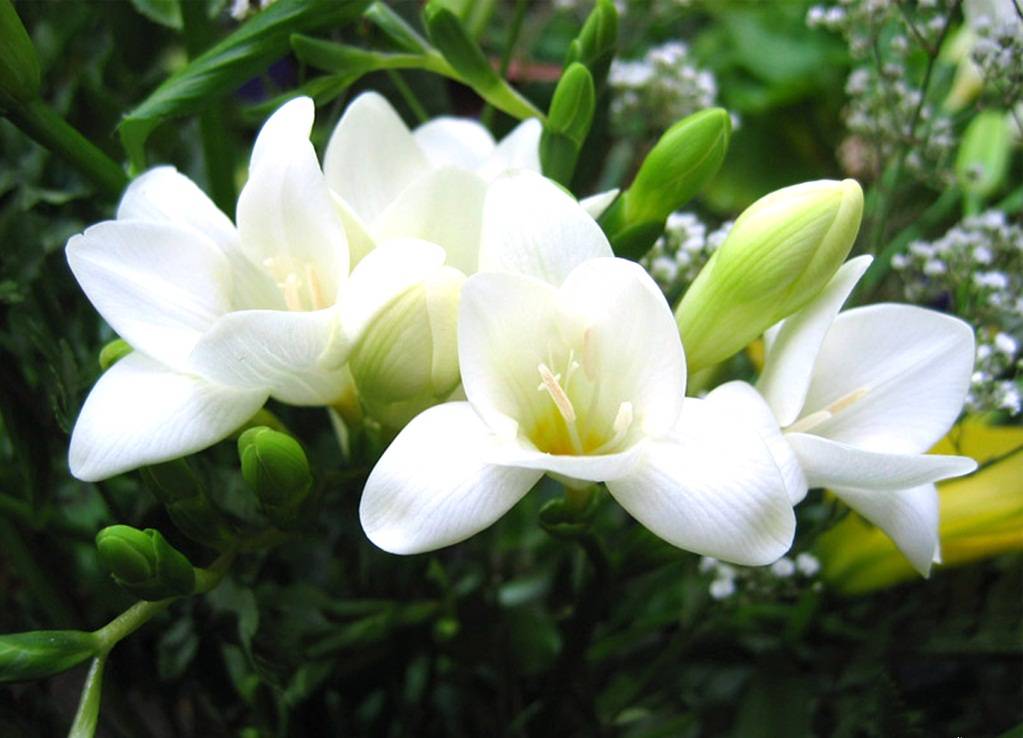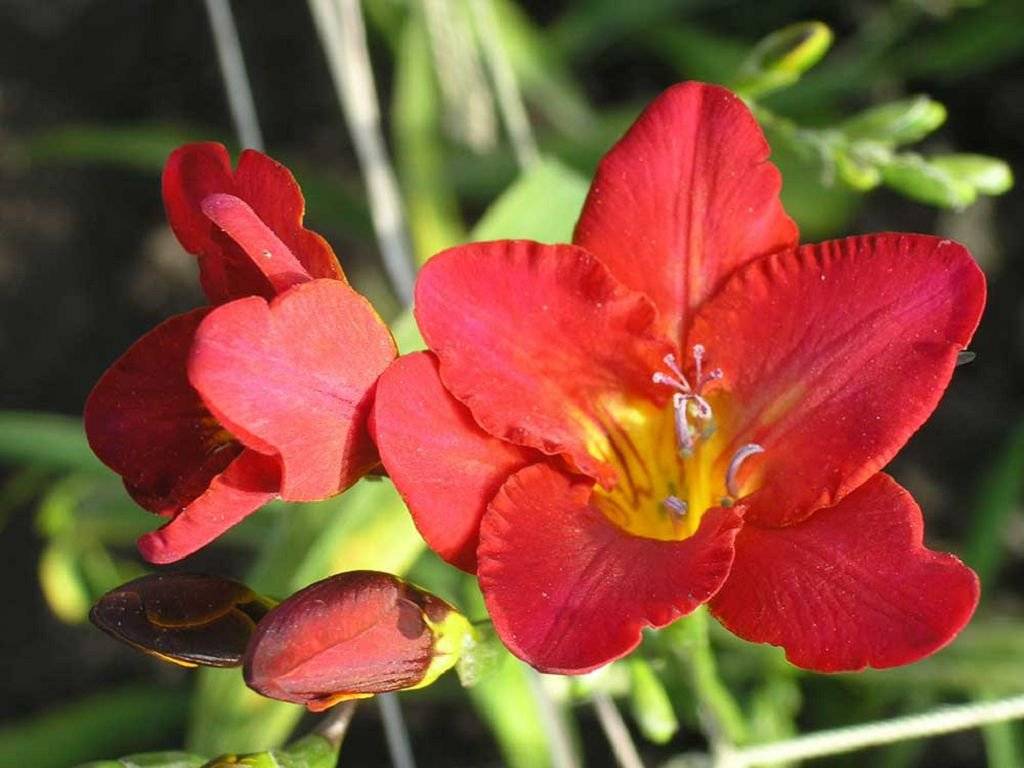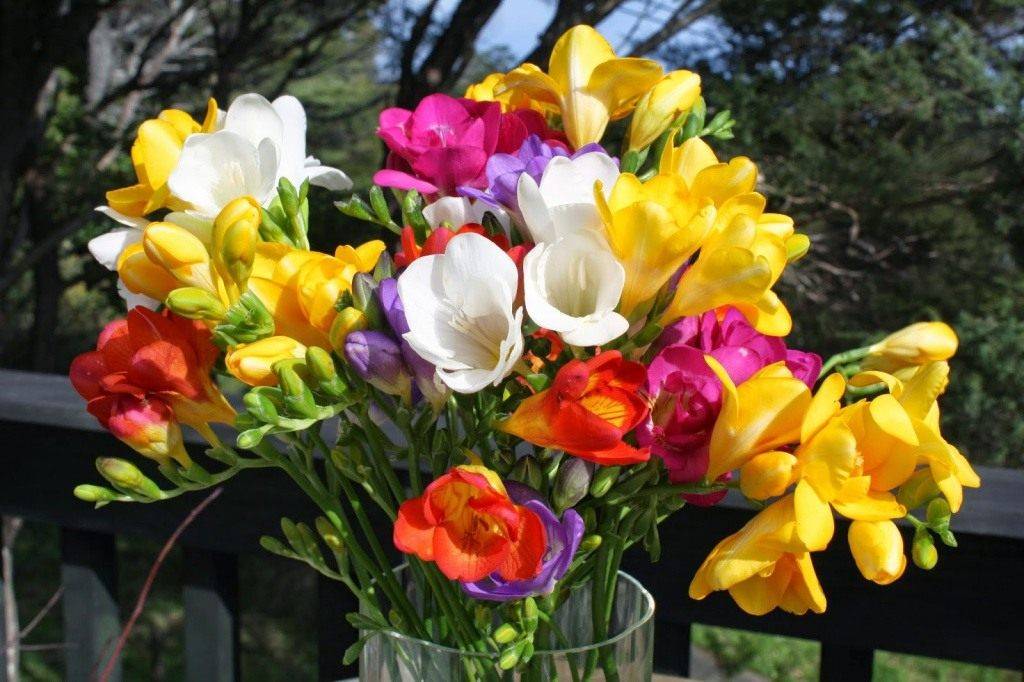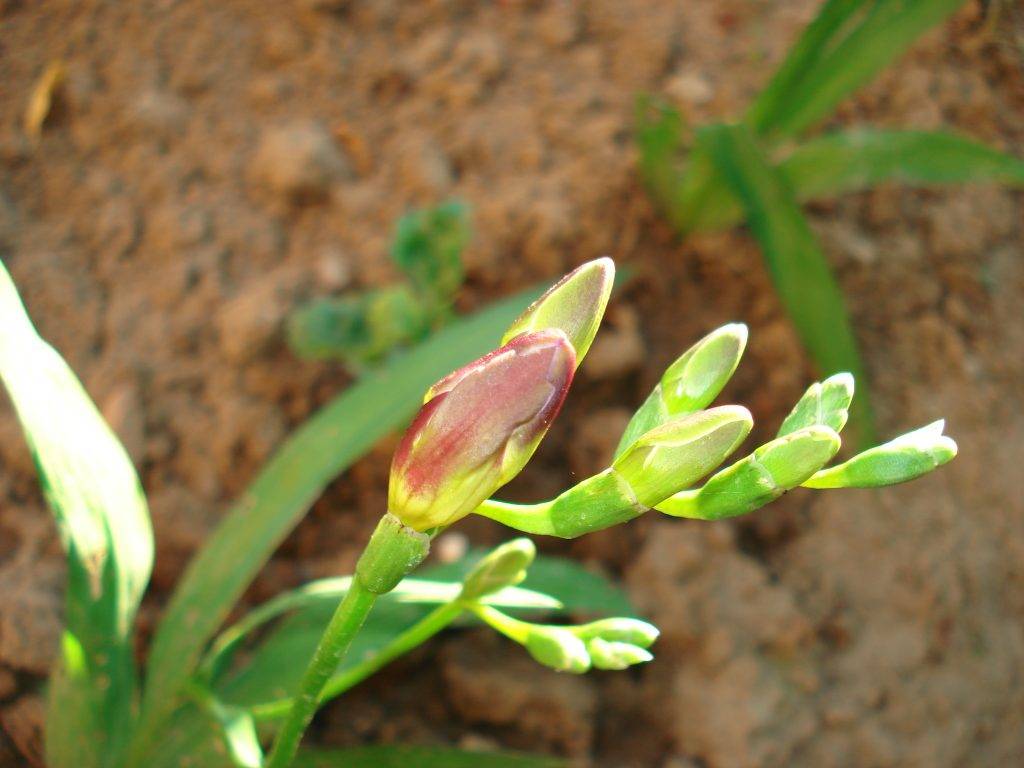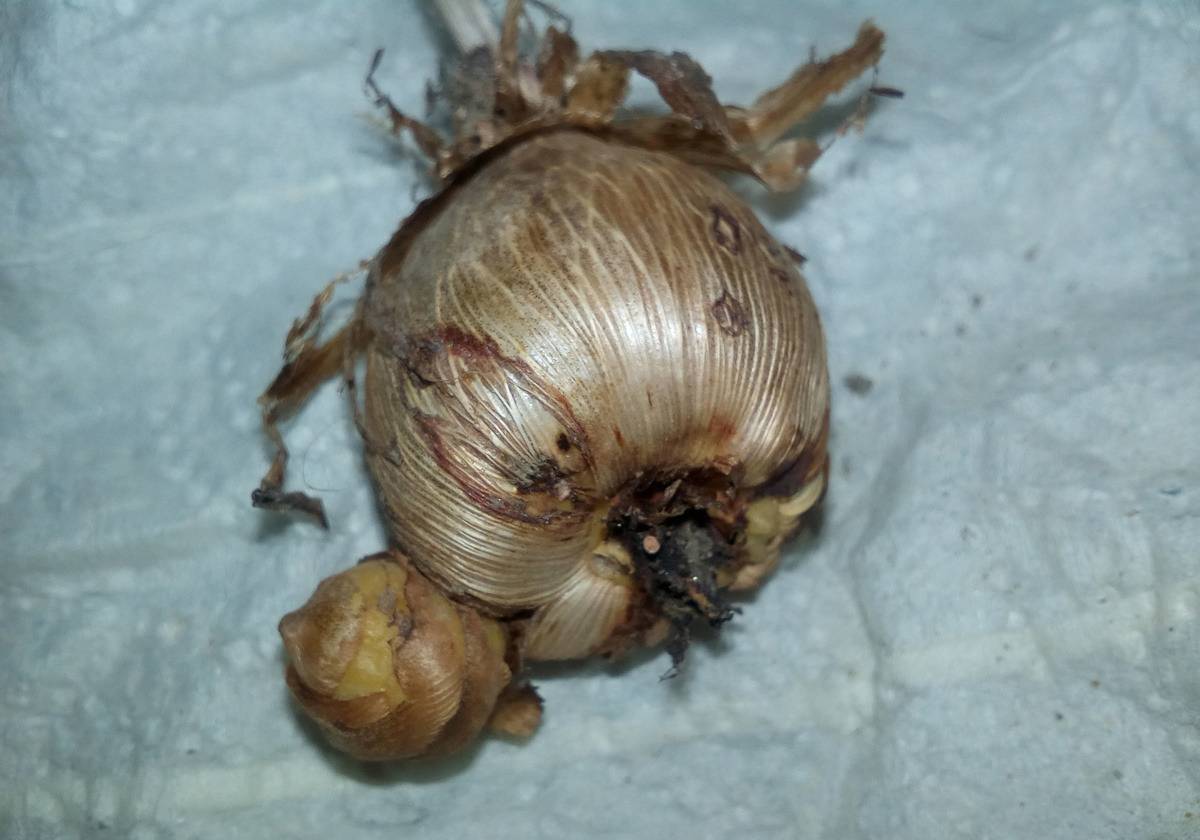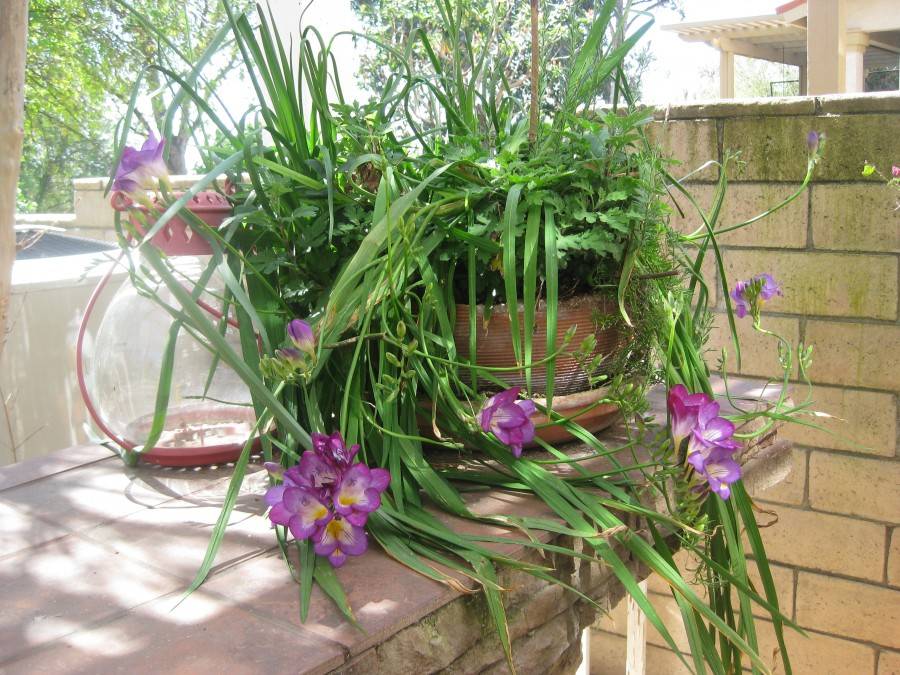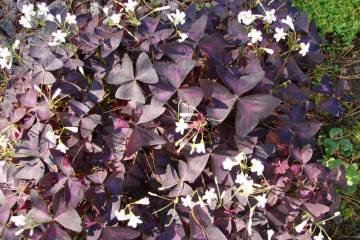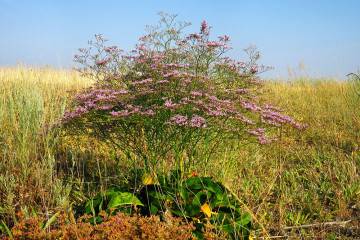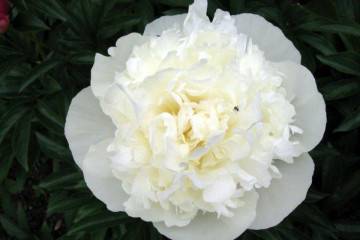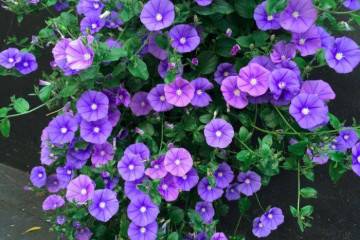Freesia flower - cultivation and care in the garden
Content:
Perennial Freesia is a flower that is cultivated both at home and in the garden. This is an exotic guest from the African continent, a representative of the Irisov family. The flower was named after the biologist F. Vries.
Description of the plant
Freesia was registered as an ornamental flower culture in the 19th century. In the nature of Africa, it grows on river banks, in the shade of large shrubs.
Botanical Description:
- Herbaceous plant with bulbous tubers.
- Brush-shaped inflorescences, sword-leaves with a prominent vein, branched, straight and thin stems from 40 cm to 75 cm high, depending on the variety.
- The shades of the petals are different: pink, blue, lilac, white, yellow. Flowering begins in early summer and lasts until autumn, since all varieties have different periods.
The graceful appearance of the flower, the delicate lily of the valley scent fell in love with many flower growers not only in Europe, but all over the world. Because of its aroma, the plant is called the Cape lily of the valley, since the Cape is a region of South Africa, the birthplace of a flower.
Types and varieties
More than two dozen types of culture are known. Three varieties of freesia flowers are most popular in Russia. The hybrid freesia is especially loved. It was bred over a hundred years ago, crossing several varieties.
Most popular:
- Freesia Armstrongii. She has raspberry, pink, dark blue, lilac bell-shaped flowers with a light citrus scent. The height of the stems is up to 70 cm. The plant was named after the English botanist who brought the bulbs to the United Kingdom.
- Refracted or broken white freesia (Freesia refracta) is one of the undersized varieties of flowers, no more than 40 cm. Delicate inflorescences of 4 or fewer flowers, yellow or milky, bloom on spreading stems in spring, in April.
- Tall hybrid freesia (Freesia hybrida) grows up to 100 cm. Inflorescences of 7-9 large, up to 6 cm in diameter, bright pink and white flowers.
Terry petals grow in two or more rows, which is why they look more magnificent than simple ones.
Other interesting varieties:
- Ballerina. Flowers with smooth petals form one row. But this does not make the white-yellow inflorescences with small folds at the base look less graceful.
- Freesia Caramel. Plant growth - 80 cm. There are 8-9 dark red flowers in the inflorescence.
- Pimperina - undersized, up to 20 cm, looks compact in the flowerbed. Folded red flowers with a darker border.
- Cardinal (Armstrong variety) is one of the luxurious flowers. The plant grows up to 75 cm. Dark red flowers have yellow spots.
- Sonnet is a tall variety, 85-90 cm. Good for bouquets. Grown in a greenhouse. Red flowers with orange spots have a sweet-sugary smell.
- Pink is a terry perennial with pale pink flowers, a pronounced aroma. It blooms for a little less than a month. The plant needs to be replanted every year.
There are a lot of varieties, among them there are noteworthy flower growers. Interesting is the Single Mix, which means: a mixture of many varieties.
Growing freesia from seeds
Freesias are both perennial and annual flowers, depending on the conditions in which they are grown.
At home - the flower is planted with bulbs, more often - hybrid varieties. Growing freesia from seeds is troublesome and risky. Not every experienced florist will get down to business. But the desire to admire beautiful flowers in the middle of winter overpowers the fear of failure.
Sowing
Before sowing, in mid-March - late April, the seeds are soaked for a day in a pale solution of potassium permanganate, Epine or Kornevin. For planting, you need light, loose soil.
Landing order:
- They take garden soil, mix with turf, leaf, peat. Purchased soil for bulbous plants is also used. Wherever the earth comes from, it is disinfected by calcining it in the oven in order to prevent diseases.
- The prepared soil is spilled with slightly warm water, the seeds are laid without deepening. Sprinkle with a layer of earth (2 cm).
- Crops are covered with cellophane or glass, kept in a warm room at a temperature of 22-24 ° C.
Plantings are poured regularly so that the soil does not become waterlogged and dry out. The sprouts will sprout for 3 weeks.
Seedling care
When the seedlings stretch upwards by 2-3 cm, they must be thinned out and the film must be removed. Seedlings are planted in separate containers or pots. The containers with crops are transferred to a cooler place: a greenhouse, a greenhouse, a winter garden, where the temperature does not exceed 16 ° C. If the seedlings are left warm, above 24 ° C, then flowering will be delayed.
Seedling care is standard.
- Before watering, the water is defended, kept to room temperature.
- Carefully, so as not to damage the young roots, loosen the soil around the sprouts.
- Young plants are fed with ammonium nitrate (nitrogen) at the rate of 20 g per 10 l of water.
The room is regularly ventilated, keeping the humidity in the room. Drafts that are detrimental to the plant are not satisfied.
Landing in open ground
Freesia is a light-loving flower, so the place of cultivation should be light for at least 12-14 hours. But the heat in direct sunlight will kill the plant. An area with light shading is the most suitable place.
The soil is dug up in autumn and spring, applying organic fertilizers: peat, manure, humus. Before planting the seedlings, holes are prepared, which are first filled with a drainage layer: crushed stone, chipped brick. Sprinkle on top with sand and peat, leaving a depth of at least 6 cm.
When to plant
Freesia is planted on the site in the second decade of May and later, when night temperatures do not drop below 0 ° C, stable warm weather will set in the street.
How to plant
Gardeners advise row planting. Seedlings are lowered into the prepared pits along with a small clod of earth, leaving a distance between them: up to 6 cm for broad-leaved plants and 4 cm for narrow-leaved plants. The intervals between the rows are 16-20 cm. The holes are leveled, mulched with peat, straw, so that the roots of freesia do not overheat.
At the end of August or in September, one or more peduncles will stretch from the seedlings.
Freesia care in the garden
Since plants are fragile, you need to prepare a support for them in advance. If there are a lot of seedlings, it is advisable to stretch a coarse mesh. Over time, for tall varieties, such as Double Freesia, the net is raised higher.
They take care of freesia saplings, as well as plants grown from bulbs:
- watered;
- feed;
- strengthen the supports;
- mulch;
- weed, loosen.
They are fed 1 time in 15 days with potassium salt - 20 g and superphosphate - 40 g per 10 L of water. Loosening and weeding are important in the early stages of the growing season.
How to water a plant
Freesia loves moisture, because it comes from the subtropics. The soil should always be moist.Therefore, the flower is watered a lot and regularly. From stagnation of water at the roots, rot will start, the plant will get sick and die.
Reproduction of freesia
The flower is bred with seeds, corms.
Seeds
At home, the seed method is rarely used. Breeders are working on this when developing new varieties. It is difficult for a gardener, even an experienced one, to grow beautiful flowers from seeds. The process is long and painstaking. Freesia is more often grown by seed on an industrial scale for forcing a variety of flowers.
Tubers
It is easier to grow flowers from tubers. For growing indoor and garden freesias, this breeding option is more often used. The bulb is formed in one growing season. When the plant blooms, a strong bulb grows overgrown with children, begins to degenerate.
At the next planting, adult bulbs and "babies" are planted separately. From mature tubers, beautiful flowers will bloom, and children will grow up. By the next planting, they will be bulbs ready to bloom.
Diseases and pests
Plant diseases are easier to prevent than to cure. Diseases in freesia, like in gladioli:
- fusarium;
- scab;
- all kinds of rot.
Freesia flower is especially loved by:
- thrips;
- aphid;
- spider mite.
Diseased plants are removed and destroyed. To avoid damage, before harvesting the bulbs, they are kept for 30-60 minutes in potassium permanganate or a solution of foundationol. The disinfection procedure is repeated before planting.
Care during and after flowering
Freesia bloom for 30-50 days. For peduncles, they equip supports or a grid. Withered flowers are cut off so that they do not take food from the plant. In prolonged hot weather, the flowers are not only watered, but also sprayed on the stems early in the morning or in the evening.
Freesia after flowering
By October, the flowers wither, the foliage turns yellow and withers. Freesia during this period is watered less often, and then stopped altogether. The peduncles are cut off.
How and when to collect seeds
In order to obtain pure-grade seeds, healthy bulbs are planted. Since freesia is a cross-pollinated plant, in order to obtain seeds, flowers are artificially pollinated (with a brush). When the flowering ends, the seed box is left until fully ripe. The dark brown color of the seed fruit indicates the time of harvest.
Sometimes the weather does not allow waiting for the seeds to ripen. Then they are collected and dried at home in a dry warm place. The finished seed is poured into a paper envelope for storage.
Preparing for winter
In the southern regions of the country, where it is not too cold, the bulbs are left to winter in the flower bed, although there is a risk of death.
In the climatic conditions of Siberia, the Urals, the central regions, the bulbs are dug up, the children are separated. After disinfection in potassium permanganate or foundation. If desired, several adult pieces can be planted at home in a pot.
Use in landscape design
It is difficult to imagine the design of flower beds, lawns, rock gardens without luxurious freesia. Flowers in pots, baskets decorate gazebos, recreation areas and smell of vanilla, lilies of the valley, citrus fruits.
Thyme, lavender, rosemary are plants with which freesia is often planted, whose smell cannot be compared with any garden flower. Freesia scent - the scent of spring, freshness. No wonder the creators of prestigious perfumery are trying to create perfumes with such a scent. But the aroma of real freesia is not in any of them. Perhaps the shape of the flowers prompted the name of the world famous brand "Freesia Light" - a lighting company.
Growing and caring for freesia is painstaking work, but worth it.Admiring fresh flowers and inhaling the scent of freesia will give you real bliss.
